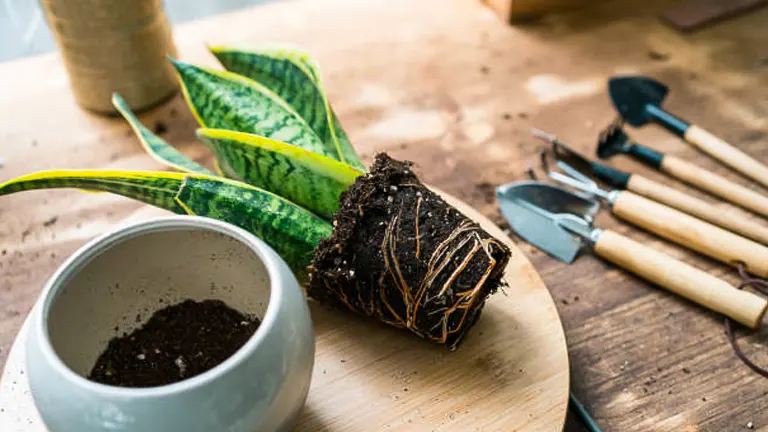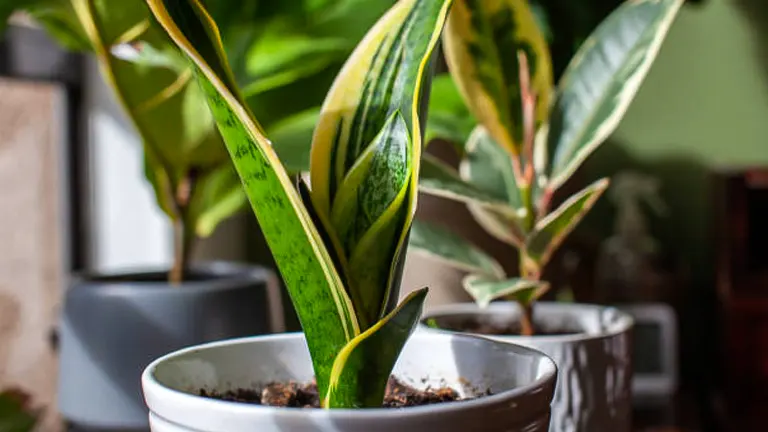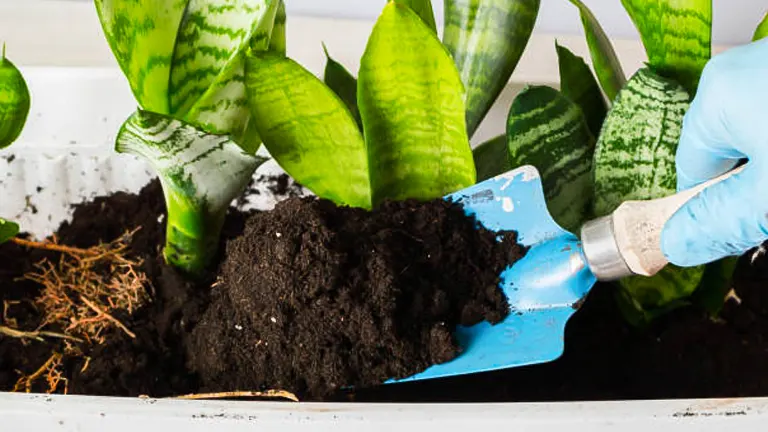How Often to Fertilize Your Snake Plant: Expert Advice and Timely Tips
- April 16, 2024
- 0 comment
Do you know when to fertilize your snake plant to achieve the best results? Proper fertilization is critical for the health and aesthetics of your snake plant. This guide offers expert advice and timely tips to help you determine the best times to provide nutrients to your plant.

We’ll help you decode the signs that your snake plant is ready for fertilization, identify the best fertilizers, and give you a schedule that makes plant care easy. Follow these steps to ensure your snake plant grows healthy and strong with vibrant leaves.
Table of Contents
- Why Fertilize Your Snake Plant?
- Creating a Fertilization Schedule
- Practical Tips for Effective Fertilization
- Maintaining Your Fertilization Plan
- Conclusion
- FAQs
Why Fertilize Your Snake Plant?

Snake plants (Sansevieria), recognized for their structural elegance and minimal care requirements, thrive best when supported by a tailored fertilization regime. This section of care is crucial not just for growth but also for the plant’s overall physiological health.
Key Nutrients Explained
- Nitrogen (N): Essential for leaf growth and vibrant coloration, nitrogen is a major component of chlorophyll and aids in the synthesis of proteins that fuel growth processes.
- Phosphorus (P): Supports the development of roots and promotes flowering, while also playing a role in energy transfer within the plant.
- Potassium (K): Crucial for overall plant health, potassium regulates stomatal opening and closing, aiding in moisture retention and drought tolerance.
Benefits of Fertilization:
- Enhanced Growth: Adequate nitrogen levels promote robust growth, leading to lush, vertically oriented leaves with intense green colorations.
- Disease Resistance: Phosphorus aids in healthy root development, which enhances the plant’s ability to absorb water and resist root-based diseases.
- Improved Resilience: Potassium improves the plant’s ability to withstand varying conditions of light and water, enhancing cellular water retention and structural integrity.
Decoding Fertilization Frequency
The ideal fertilization schedule for snake plants depends heavily on environmental conditions, plant age, and inherent soil fertility. Scientifically, the metabolism of snake plants dictates less frequent need for nutrient supplementation compared to more rapidly growing plants.
Factors Influencing Fertilization Frequency
- Plant Age and Size:
- Juveniles: Require more frequent fertilization to support their rapid developmental phases.
- Mature Plants: Benefit from reduced fertilization as their growth rate stabilizes.
- Soil Nutrient Levels:
- Plants in enriched soils with high organic content may require fewer applications of fertilizer.
- Environmental Conditions:
- Light: More light equates to faster growth and potentially increased nutrient needs.
- Temperature and Humidity: Higher temperatures and lower humidity levels can increase water and nutrient uptake rates.
Seasonal Variations in Nutrient Requirements
| Season | Fertilization Frequency | Rationale |
|---|---|---|
| Spring and Summer | Every 3-4 weeks | Active growth phase requires more nutrients. |
| Fall and Winter | Once every 2 months | Dormancy slows metabolism, reducing need. |
Scientific Insight
During the active growing season (spring to summer), snake plants typically exhibit increased photosynthetic and metabolic activity, necessitating higher levels of nitrogen for chlorophyll production and potassium for water regulation. In contrast, during the cooler dormant season, metabolic activities reduce, and the nutrient demand significantly drops.
Advanced Recommendations:
- Use of Slow-Release Fertilizers: These fertilizers break down and release nutrients gradually, providing a steady supply that supports growth over several months without the risk of chemical burn or shock from over-fertilization.
- Liquid vs. Granular Fertilizers:
- Liquid Fertilizers: Offer quick-release and fast-acting solutions ideal during the peak growth phase.
- Granular Fertilizers: Are more suited for extended release and ideal for baseline nutrient provision.
- Organic Amendments:
- Incorporating compost or worm castings can enhance soil texture and fertility, providing slow-releasing nutrients in a form readily accessible to the roots.
Creating a Fertilization Schedule
Establishing Your Fertilization Schedule

Creating a precise and effective fertilization schedule for your snake plant is not just about enhancing its growth but also about optimizing its overall health and resilience to environmental stresses. This schedule should be meticulously tailored to the plant’s specific lifecycle stages and the unique environmental conditions of your home or garden.
Assessing Plant Health and Soil Quality
- Initial Assessment: Conduct a comprehensive health check focusing on leaf color, texture, and overall vigor. Use a standardized Plant Health Index (PHI) where 1 indicates poor health and 5 signifies excellent health, based on visible signs like leaf color (from pale to rich green) and texture (from floppy to firm).
- Soil Testing: Employ a soil test kit or seek a laboratory analysis annually to obtain precise data on pH levels, macronutrient (NPK) concentrations, and trace minerals. This scientific approach allows for tailored fertilization strategies.
Soil Nutrient Guidelines for Snake Plants
| Nutrient | Optimal Range (ppm) |
|---|---|
| Nitrogen (N) | 150 – 200 |
| Phosphorus (P) | 30 – 50 |
| Potassium (K) | 150 – 200 |
| pH Level | 6.0 – 7.0 |
Frequency of Fertilization
- Young Plants: Initiate fertilization at 6-week intervals, adjusting based on the PHI score and soil nutrient data. Young plants in their formative stage exhibit increased nutrient uptake, supporting rapid development.
- Established Plants: Transition to an 8-week fertilization schedule during active growth periods, with an emphasis on sustaining health and enhancing resilience.
- Seasonal Adjustments: Utilize environmental data to align fertilization with growth cycles. During increased daylight hours (spring and summer), escalate frequency to support photosynthesis and growth. Reduce in the dormant season to prevent nutrient excess.
Monthly Guidelines
| Month | Action | Rationale |
|---|---|---|
| January | No fertilization | Dormant period; minimal nutrient requirements. |
| February | Prepare for fertilization (soil testing) | Assess soil conditions before the growth season. |
| March | Begin fertilizing; apply a balanced 10-10-10 NPK fertilizer | Start of the growth season; roots absorb nutrients for new growth. |
| April | Fertilize as in March | Support rapid spring growth. |
| May | Continue with the same regimen | Promote development before summer. |
| June | Shift to a nitrogen-rich fertilizer if growth is suboptimal | Mid-growth season adjustment for foliage development. |
| July | Maintain nitrogen-rich fertilization | Peak growth period; high nitrogen supports foliage. |
| August | Revert to balanced fertilizer as growth stabilizes | Prepare plant for end of growing season. |
| September | Last month for regular fertilization | Transition to pre-dormancy feeding. |
| October | Reduce frequency, prepare for dormancy | Decrease nutrient supply as growth slows. |
| November | Fertilize only if signs of undernourishment | Minimal fertilization as plant prepares for winter. |
| December | No fertilization | Dormant season; plant is resting. |
Selecting and Applying the Right Fertilizer
- Choosing the Right Fertilizer: Opt for a balanced, water-soluble fertilizer or a slow-release formula tailored to snake plants, considering the NPK ratio that matches the plant’s current nutrient requirements identified through soil testing.
- Organic Alternatives: Explore the use of compost for gradual nutrient release or fish emulsion for a quick, balanced nutrient boost, especially beneficial during peak growth phases.
Fertilizer Application Techniques
| Technique | Description | Benefit |
|---|---|---|
| Dilution | Reduce strength to 50% of manufacturer’s recommendation | Minimizes risk of root burn |
| Even Distribution | Apply around the soil’s perimeter | Ensures root zone coverage |
| Post-Watering | Water immediately after application | Aids in nutrient dispersion |
Innovative Practices for Fertilization:
- Micro-dosing: Apply smaller amounts of fertilizer more frequently, adapting to the plant’s growth responses and environmental changes. This method prevents shock and allows for finer adjustments.
- Leaf Spray Application (Foliar Feeding): Utilize a diluted solution of liquid fertilizer to lightly mist the leaves. This method can be particularly effective during the growth phase, allowing for direct absorption of nutrients through the stomata.
- Root Zone Injection: For mature or large snake plants, consider direct root zone injection of liquid fertilizer, ensuring nutrients are delivered precisely where needed.
Practical Tips for Effective Fertilization

Proper fertilization is crucial not just for growth but for maintaining the overall health of snake plants. It requires more than just applying the right type of fertilizer; it demands precision in application techniques, timing, and consistent monitoring of the plant’s response. Below are elaborated strategies to ensure optimal fertilization:
Advanced Application Techniques
- Root Zone Fertilization: Applying fertilizer at the edge of the plant’s root zone minimizes risks of root burn, which can severely damage the plant’s ability to absorb water and nutrients. This method involves sprinkling or pouring fertilizer around the periphery, not directly on the stem or central root mass, to distribute nutrients evenly through the soil where roots can best access them.
- Liquid Fertilizer Application: Liquid fertilizers must be diluted to half the recommended concentration to prevent nutrient overload, which can lead to leaf burn and even root damage. It’s critical to apply these diluted solutions directly to the soil rather than the leaves. This direct soil application ensures that the nutrients penetrate the root zone where they are needed most without wasting resources on the less effective foliar uptake.
- Using Slow-Release Granules: Slow-release granules are preferred for their ability to provide a steady nutrient supply over an extended period, thus stabilizing plant growth rates and avoiding the boom-and-bust cycle associated with soluble fertilizers. Evenly distribute these granules around the soil’s surface within the root radius.
Fertilization Frequency and Timing
Maintaining a consistent fertilization schedule is paramount to supporting the snake plant’s growth cycles. The optimal times for fertilization are early morning or late evening when temperatures are cooler to reduce evaporation losses and enhance nutrient uptake.
Timing and Frequency Table
| Growth Phase | Frequency | Time of Day | Notes |
|---|---|---|---|
| Active Growth (Spring-Summer) | Every 4 weeks | Early morning or late evening | Aligns with rapid growth needs; avoids heat of day. |
| Dormant (Fall-Winter) | Every 8-12 weeks | Early morning or late evening | Reduced metabolic activity calls for less frequent feeding. |
Recognizing Signs of Fertilization Issues
Over-Fertilization Indicators:
- Salt Buildup: Excess fertilizer can accumulate as white, crusty deposits on the soil surface, indicating high levels of mineral salts which can lead to osmotic stress and dehydration of roots.
- Leaf Symptoms: Tips or edges of leaves turning brown and curling up are classic signs of chemical burn from over-fertilization, while overall leaf wilting despite adequate soil moisture suggests toxic levels of nutrient buildup.
Correction Strategies:
- Soil Leaching: This involves irrigating the soil thoroughly to flush out excess salts, repeated several times with intervals allowing the soil to dry slightly between sessions.
- Fertilizer Adjustment: Reduce both the concentration and frequency of fertilizer applications, and consider switching to a less potent fertilizer formula.
Under-Fertilization Indicators:
- Growth Retardation: Slower than usual growth rates can be a sign of nutrient deficiency.
- Foliage Discoloration: Leaves turning pale or yellow, particularly along the veins, usually indicate a deficiency in key nutrients such as nitrogen.
Correction Strategies:
- Incremental Fertilization: Gradually increase the fertilizer dose, monitoring the plant’s response to avoid shock. This might include more frequent applications of a balanced nutrient solution.
Troubleshooting Common Fertilization Problems
Choosing the incorrect type of fertilizer can lead to nutrient imbalances. For snake plants, which generally require low to moderate nutrient levels, a balanced, slow-release fertilizer with an NPK ratio of 10-10-10 is often sufficient.
Environmental Considerations:
- Light Levels: High light can increase photosynthetic activity and nutrient demand; conversely, low light reduces these needs.
- Humidity and Temperature: High temperatures can intensify evaporation and transpiration, speeding up nutrient consumption. Low humidity levels might concentrate nutrients in the soil, increasing the risk of salt stress.
Disease and Pest Management: Vigilant monitoring for pest activity or signs of disease is crucial, as these can compromise the plant’s health and its ability to utilize nutrients effectively. Treat infestations or diseases promptly with appropriate, preferably organic, pest control solutions to minimize further stress on the plant.
Maintaining Your Fertilization Plan

To ensure the long-term health and vigor of your snake plant, it’s crucial to maintain a balanced and responsive fertilization plan. Regular monitoring and adjustments will help you cater to the changing needs of your plant over time.
Monitoring Plant Health
- Regular Check-Ups: Inspect your plant regularly for signs of both over-fertilization and under-fertilization. Pay attention to leaf color and growth patterns.
- Annual Soil Tests: Conduct soil tests annually to assess nutrient levels and pH, which can significantly impact plant health. Adjust your fertilization strategy based on the results to ensure your snake plant receives the optimal balance of nutrients.
Adjusting the Fertilization Schedule
- Seasonal Adjustments: As discussed, decrease fertilization frequency during the dormant winter months and increase during the active growing season in spring and summer.
- Response to Environmental Changes: If you change the plant’s location or if there are significant changes in environmental conditions (like light intensity, temperature, and humidity), reassess your fertilization needs. Plants in brighter, warmer conditions may require more frequent fertilization.
Long-Term Care Strategies
- Rotation Between Fertilizers: Alternating between different types of fertilizers (e.g., switching between organic and inorganic) can prevent nutrient build-up and exposure to potentially harmful chemicals.
- Incorporating Organic Matter: Periodically mix organic matter such as compost or worm castings into the soil to improve its structure and nutrient content, offering a slow-release nutrient source that’s gentle on the plant.
Related Post
- How to Fertilize a Mango Tree Effectively: Tips and Tricks for Healthy Growth
- How to Fertilize Apple Trees: Essential Tips for a Bountiful Harvest
- How to Fertilize Lemon Trees: Secrets for Thriving Citrus
- How to Fertilize Avocado Tree: A Step-by-Step Guide for Lush Growth
Conclusion
Fertilizing your snake plant is a delicate balance that needs attention and precision. By establishing a proper schedule, choosing the right fertilizer, and applying it correctly, you can significantly enhance your snake plant’s health and growth. Remember, the key is consistency and observation—adjust as necessary based on the plant’s response and environmental conditions.
FAQs
- What is the best time of year to start fertilizing a snake plant?
The optimal time to start fertilizing a snake plant is during the spring. This season marks the beginning of its active growth period when the plant can best utilize additional nutrients. Begin fertilization when you notice new growth appearing, usually in early to mid-spring. - How can I tell if I am fertilizing my snake plant too much?
Signs of over-fertilization include salt buildup on the soil surface, which appears as a white, crusty layer, brown tips or edges on the leaves, and wilting or soft leaves despite regular watering. If you notice these symptoms, reduce the frequency and amount of fertilizer you’re applying. - Can I use coffee grounds as a fertilizer for my snake plant?
While coffee grounds are popularly used for acid-loving plants, they should be used cautiously with snake plants. They can be beneficial when added sparingly to the compost or mixed into the soil as they add organic matter and can help with drainage. However, direct application of fresh coffee grounds can lead to over-acidifying the soil and should generally be avoided. - Is it necessary to fertilize a snake plant during its dormant season?
During the dormant season (fall and winter), it is not necessary to fertilize a snake plant. Growth slows down significantly during this time, and the plant does not require as many nutrients. Fertilizing during dormancy can lead to nutrient build-up and potential root burn, harming the plant. - What type of fertilizer is best for snake plants?
A balanced, water-soluble fertilizer with equal parts nitrogen, phosphorus, and potassium (such as a 10-10-10 mix) is ideal for snake plants. Alternatively, a slow-release granular fertilizer can be used. These fertilizers should be applied at half-strength to prevent nutrient overload and potential root damage. - How does the pot size affect how often I should fertilize my snake plant?
Pot size can influence fertilization frequency. In a smaller pot, soil nutrients can be depleted more quickly because there is less soil to hold nutrients, requiring more frequent fertilization. However, always ensure to adjust the amount of fertilizer proportionally to avoid over-fertilization. - Should I alter my fertilization strategy if my snake plant is in low light conditions?
Yes, snake plants in low light conditions should be fertilized less frequently than those in bright, indirect light. Limited light slows down photosynthesis and the plant’s overall metabolism, reducing its nutrient requirements. Fertilizing sparingly will prevent potential salt buildup and root burn from unused nutrients. - What should I do if my snake plant has stopped growing even with regular fertilization?
If your snake plant has stopped growing despite regular fertilization, consider several factors: the adequacy of light, water, and temperature conditions. Over-fertilization could also be a culprit, where excess nutrients lock out essential water and micro-nutrients from the roots. Pause fertilizing, check environmental conditions, and possibly repot the plant if the soil has become excessively saline or compacted.
Fertilize your snake plant wisely—more in spring and summer, less in fall and winter. Follow these tips to keep your plant healthy and thriving all year round.

Kristine Moore
Forestry AuthorI'm Kristine Moore, a seasoned garden landscaping professional with over 30 years of experience. My extensive career has been dedicated to transforming outdoor spaces into stunning, sustainable landscapes. With a deep understanding of horticulture, design principles, and environmental stewardship, I have become a respected figure in the field, known for creating harmonious, visually appealing, and eco-friendly gardens. My commitment to excellence and continuous learning in landscaping trends and techniques has solidified my reputation as an expert in garden design and implementation.













Leave your comment